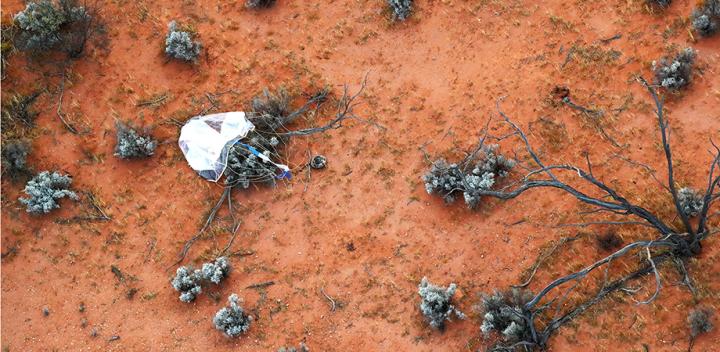Details of the successful mission will be discussed during the SPIE Astronomical Telescopes + Instrumentation Digital Forum

Credit: JAXA.
BELLINGHAM, Washington, USA — As part of the opening plenary session at the SPIE Astronomical Telescopes + Instrumentation Digital Forum, Hitoshi Kuninaka, of the Japan Aerospace Exploration Agency, will be discussing and responding to audience questions about the successful return of the Hayabusa2 capsule from its asteroid-sample mission, a second-time-in-history-success that marks exciting and innovating advances for the astronomical-instrumentation community. In addition, Kuninaka may have initial information regarding what potential treasures the capsule’s sample container holds.
“I’m so excited to hear more about this mission,” says SPIE Astronomical Telescopes + Instrumentation Chair Alison Peck. “The level of precision needed to pull this off — for the navigation as well as the engineering that went into the spacecraft itself — is just mind-blowing. This really ushers in a new era of ‘in-person’ study of the composition of these solar system bodies.”
SPIE Astronomical Telescopes + Instrumentation Digital Forum, showcasing and sharing the latest in space- and ground-based telescopes and related engineering, runs 14-18 December. The interactive plenary session — as well as the rest of the digital forum — will be accessible online, and registration to the event is free and open to the public. The plenary session is scheduled for 12 to 2 PM Pacific Time on 14 December.
This is the second successful Hayabusa attempt to bring asteroid material to Earth: in 2010, the original Hayabusa capsule brought back samples from the asteroid Itokawa, a pioneering success which allowed scientists to learn Itokawa’s age and geologic history. This week’s sample materials stem from an 18-month rendezvous that Hayabusa2 — launched in 2014 — had with Ryugu, a carbonaceous, or C-type, asteroid, a class of asteroid believed to contain organic materials and hydrates. During its year-and-a-half meet-up, Hayabusa2 observed Ryugu remotely as well as collecting material and data from the astral body’s surface and subsurface. The Hayabusa missions are historical firsts, the only successful sample-return missions so far.
“We think that asteroids, comets, and cosmic dust played important roles in terms of transferring material inside the solar system, and Hayabusa and Hayabusa2 have inspired us to explore the above hypothesis,” says Kuninaka. “If the asteroid Ryugu is indeed confirmed to be shown to be carbon rich, there is a strong possibility of resource utilization for the international human space exploration.”
“They have done a fantastic job in completing all actions of this mission without major failures,” notes SPIE Astronomical Telescopes + Instrumentation Chair Satoru Iguchi. “A lot of technically challenging goals were successfully achieved, including touchdown on the asteroid Ryugu, the collection of samples, and a successful return to Earth. Just as exciting, an investigation of the samples should offer us a deeper understanding of the origin of life.”
###
About SPIE
SPIE is the international society for optics and photonics, an educational not-for-profit organization founded in 1955 to advance light-based science, engineering, and technology. The Society serves more than 258,000 constituents from 184 countries, offering conferences and their published proceedings, continuing education, books, journals, and the SPIE Digital Library. In 2020, SPIE provided over $5.8 million in community support including scholarships and awards, outreach and advocacy programs, travel grants, public policy, and educational resources. www.spie.org.
Contact:
Daneet Steffens
Public Relations Manager
[email protected]
+1 360 685 5478
@SPIEtweets
Media Contact
Daneet Steffens
[email protected]
Original Source
https:/




